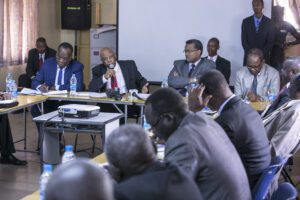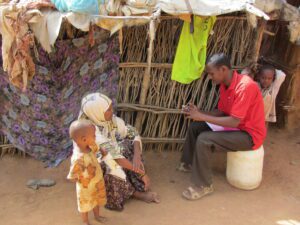Introduction
Monitoring and Evaluation (M&E) underpin effective development programs across Uganda. Whether you’re an NGO officer, government planner, or private consultant, accessing quality M&E training in Uganda is your first step toward delivering measurable impact. In this guide, we’ll explore what M&E training in Uganda entails, why it matters, who offers it, and how you can leverage capacity building for stronger, evidence‑based projects.
1. What Is M&E Training in Uganda?
M&E training in Uganda refers to structured learning programs—workshops, short courses, or certificate schemes—focused on planning, collecting, analyzing, and reporting data to assess project performance. These programs cover:
- Fundamentals of Monitoring & Evaluation
- Designing indicators and logic models
- Data collection methods (qualitative and quantitative)
- Mobile data collection platforms
- Data analysis and visualization
- Report writing and stakeholder communication
Through M&E training in Uganda, professionals gain practical skills to track progress, troubleshoot implementation gaps, and demonstrate results to funders and communities.
2. Why Invest in Capacity Building for M&E?
- Improved Project Outcomes
Quality M&E training in Uganda equips teams to set realistic targets and measure success, reducing wasted resources. - Accountability to Stakeholders
Funders increasingly demand evidence. Solid M&E training in Uganda ensures you deliver transparent reports. - Adaptive Management
When staff understand M&E methodologies, they can pivot strategies based on real‑time feedback. - Enhanced Professional Growth
Professionals who complete M&E training in Uganda become more competitive in the job market.
3. Key Components of Effective M&E Training in Uganda
An impactful M&E training in Uganda program typically includes:
- Theory & Concepts: Logic models, theory of change, indicator frameworks.
- Practical Exercises: Case studies from Ugandan sectors—education, health, agriculture.
- Field Assignments: Real‑world data collection using tools like KoBoToolbox or ODK.
- Data Analysis Workshops: Hands‑on sessions with Excel, SPSS, or R.
- Reporting Clinics: Best practices for crafting policy briefs and stakeholder presentations.
Each module of M&E training in Uganda reinforces both knowledge and application, creating well‑rounded practitioners.
4. Who Offers M&E Training in Uganda?
Universities & Academic Institutions
- Makerere University School of Social Sciences
- Uganda Management Institute’s Centre for M&E
- International NGOs & Development Partners
- UNDP Uganda’s Evaluation Capacity Development initiatives
- World Bank Uganda M&E workshops
- Independent Training Providers
- QDIC Academy (Quantum Dynamics Impact Consulting)
- Customized in‑house courses by consultancy firms
- Online Platforms with Local Adaptation
- Coursera’s M&E specializations with localized case studies
- African Evaluation Association’s e‑learning modules
Choosing the right provider ensures your M&E training in Uganda matches your organization’s sector and scale.
5. Formats of M&E Training in Uganda
- In‑Person Workshops
Intensive 3–5 day sessions, ideal for hands‑on practice and networking. - Short Certificate Courses
4–12 weeks, blending theory, assignments, and final assessments. - Online & Blended Learning
Self‑paced modules plus virtual discussions—good for remote teams. - On‑the‑Job Coaching
Tailored mentorship embedded within your project, offering real‑time feedback.
Each format of M&E training in Uganda has its advantages. In‑person sessions boost collaboration, while online courses provide flexibility.
6. Common Challenges Addressed by M&E Training in Uganda
What are the common challenges in M&E in Uganda?
- Limited Technical Skills
Many practitioners lack formal training in indicator design or data analysis. Quality M&E training in Uganda bridges this gap. - Connectivity Constraints
Rural data collection faces network issues. Training covers offline‑capable tools and strategies. - Data Quality Issues
Mistakes in entry or poor survey design. Emphasis on validation techniques in M&E training in Uganda reduces errors. - Siloed Departments
M&E units often isolated. Good training promotes cross‑team collaboration. - Resource Constraints
Limited budgets for software. Courses highlight affordable or open‑source solutions.
7. Why M&E Is Important for Projects in Uganda
Why is M&E important for projects in Uganda?
- Ensures Accountability to communities and funders
- Drives Evidence‑Based Policy by providing reliable data
- Optimizes Resource Use by identifying inefficiencies
- Strengthens Learning through lessons captured and shared
By enrolling in M&E training in Uganda, project teams institutionalize these benefits.
8. The Future of M&E in Uganda
What is the future of M&E in Uganda?
- AI & Predictive Analytics: Forecasting project success and risk mitigation.
- Mobile & Geo‑Enabled Data: Real‑time mapping of interventions.
- Participatory Approaches: Engaging beneficiaries in data collection via community scorecards.
- Data Dashboards: Live visualizations integrated with management systems.
Staying current through advanced M&E training in Uganda ensures practitioners are ready for these innovations.
9. Government Support for M&E in Uganda
How does the government support M&E in Uganda?
- National M&E Policy Framework under the Office of the Prime Minister
- Sector Performance Reports published by ministries with M&E budgets
- Public–Private Partnerships funding training initiatives
- District M&E Units offering localized capacity building
Leveraging these structures amplifies the impact of your M&E training in Uganda.
10. Role of Evaluation Capacity Development in Uganda’s Development
What role does evaluation capacity development play in Uganda’s development?
- Institutionalizing Learning: Embedding M&E into government planning cycles.
- Promoting Transparency: Publicly accessible evaluation reports.
- Enhancing Service Delivery: Data‑driven improvements in health, education, agriculture.
- Strengthening Local Governance: Enabling district councils to monitor budgets and outputs.
Quality M&E training in Uganda is the cornerstone of evaluation capacity development.
11. Dominant Approaches to M&E in UgandaWhat are the dominant approaches to M&E in Uganda?
- Logical Framework Approach (LogFrame)
- Theory of Change (ToC)
- Results‑Based Management (RBM)
- Realist Evaluation
- Participatory M&E
Effective M&E training in Uganda often covers all these approaches, allowing teams to choose the best fit.
12. International Organizations’ Contribution to M&E Capacity Building
How do international organizations contribute to M&E capacity building in Uganda?
- UN Agencies: UNDP, UNICEF offering regional workshops.
- Funding Agencies: USAID’s ME&L (Monitoring, Evaluation & Learning) training grants.
- Development Banks: World Bank’s Evaluation Academy scholarships.
- Global Networks: African Evaluation Association’s annual conferences held in Kampala.
Partnering with these bodies enriches any M&E training in Uganda program.
13. Effectiveness of “Management by Results” Approaches
How effective are “management by results” approaches in Uganda’s M&E?
- RBM improves focus on outputs, but requires strong indicator frameworks.
- Programs with prior M&E training in Uganda show higher compliance with RBM standards.
- Ongoing training reinforces result‑oriented mindsets among project teams.
14. Impact of Evaluation Capacity Development on Local Governance
What is the impact of evaluation capacity development on local governance in Uganda?
- District officials trained in M&E prepare better Annual Performance Reports.
- Community scorecards co‑created with local leaders increase accountability.
- M&E training in Uganda for local councilors boosts their oversight functions.
15. How M&E Addresses Poverty in Uganda
How does M&E address poverty in Uganda?
- By tracking livelihoods indicators—income, food security, access to services—over time.
- Enabling mid‑course corrections in poverty alleviation programs.
- Training grassroots organizations through M&E training in Uganda ensures data‑driven interventions.
FAQs
What are the common challenges in M&E in Uganda?
Limited technical skills, connectivity constraints, data quality issues, siloed departments, and resource constraints.
Why is M&E important for projects in Uganda?
It ensures accountability, evidence‑based policy, resource optimization, and institutional learning.
What is the future of M&E in Uganda?
AI, mobile geo‑data, participatory approaches, and real‑time dashboards shape tomorrow’s practice.
How does the government support M&E in Uganda?
Through a national M&E framework, sector performance reports, public–private partnerships, and district M&E units.
What role does evaluation capacity development play in Uganda’s development?
It institutionalizes learning, promotes transparency, enhances service delivery, and strengthens local governance.
What are the dominant approaches to M&E in Uganda?
LogFrame, Theory of Change, Results‑Based Management, Realist Evaluation, and Participatory M&E.
How do international organizations contribute to M&E capacity building in Uganda?
Agencies like UNDP, USAID, and the World Bank provide workshops, grants, and scholarships.
How effective are “management by results” approaches in Uganda’s M&E?
They improve focus on outputs but require robust indicator design and ongoing M&E training in Uganda.
What is the impact of evaluation capacity development on local governance in Uganda?
Enhanced reporting by district officials, increased accountability via community scorecards, and stronger oversight by councilors.
How does M&E address poverty in Uganda?
By monitoring livelihood indicators, enabling course corrections, and training grassroots stakeholders.






